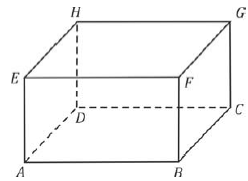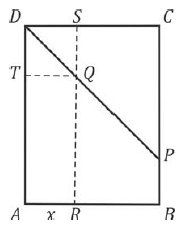Questões de Vestibular USP 2016 para Vestibular - Primeira Fase
Foram encontradas 90 questões
O paralelepípedo reto-retângulo ABCDEFGH representado na figura, tem medida dos lados AB = 4, BC = 2 e BF = 2

O seno do ângulo HÂF é igual a
O retângulo ABCD, representado na figura, tem lados de comprimento AB = 3 e BC = 4. O ponto P pertence ao lado  = 1. Os pontos R, S e T pertencem aos lados
= 1. Os pontos R, S e T pertencem aos lados 
 , respectivamente. O segmento
, respectivamente. O segmento  é paralelo a
é paralelo a  e intercepta
e intercepta  no ponto Q. O segmento
no ponto Q. O segmento  é paralelo a
é paralelo a 

Sendo x o comprimento de  , o maior valor da soma das áreas do retângulo
, o maior valor da soma das áreas do retângulo  , do triângulo CQP e do triângulo DQS, para x variando no intervalo aberto ] 0,3[, é
, do triângulo CQP e do triângulo DQS, para x variando no intervalo aberto ] 0,3[, é
Na figura, o retângulo ABCD tem lados de comprimento AB = 4 e BC = 2. Sejam M o ponto médio do lado  e N o ponto médio do lado
e N o ponto médio do lado  . Os segmentos
. Os segmentos  interceptam o segmento
interceptam o segmento  nos pontos E e F, respectivamente.
nos pontos E e F, respectivamente.

A área do triângulo AEF é igual a
Considere as funções  em que o domínio de f é o conjunto dos números reais e o
domínio de g é o conjunto dos números reais maiores do
que 0. Seja
em que o domínio de f é o conjunto dos números reais e o
domínio de g é o conjunto dos números reais maiores do
que 0. Seja

em que x > 0. Então, h(2) é igual a
O polinômio P(x) = x3 - 3x2 + 7x - 5 possui uma raiz
complexa  cuja parte imaginária é positiva. A parte real de
cuja parte imaginária é positiva. A parte real de  é igual a
é igual a
Um reservatório de água tem o formato de um cone circular reto. O diâmetro de sua base (que está apoiada sobre o chão horizontal) é igual a 8 m. Sua altura é igual a 12 m. A partir de um instante em que o reservatório está completamente vazio, inicia-se seu enchimento com água a uma vazão constante de 500 litros por minuto. O tempo gasto para que o nível de água atinja metade da altura do reservatório é de, aproximadamente,

Duas circunferências com raios 1 e 2 têm centros no primeiro quadrante do plano cartesiano e ambas tangenciam os dois eixos coordenados. Essas circunferências se interceptam em dois pontos distintos de coordenadas (x1 , y1) e (x2 , y2).
O valor de  é igual a
é igual a
Uma quantidade fixa de um gás ideal é mantida a temperatura constante, e seu volume varia com o tempo de acordo com a seguinte fórmula:

em que t é medido em horas e V(t) é medido em m3. A
pressão máxima do gás no intervalo de tempo [0,2] ocorre
no instante